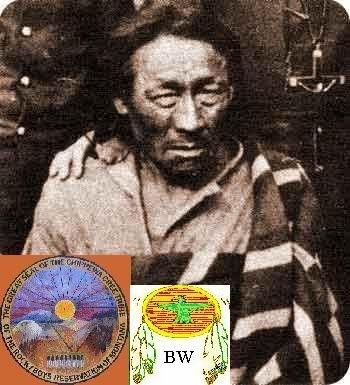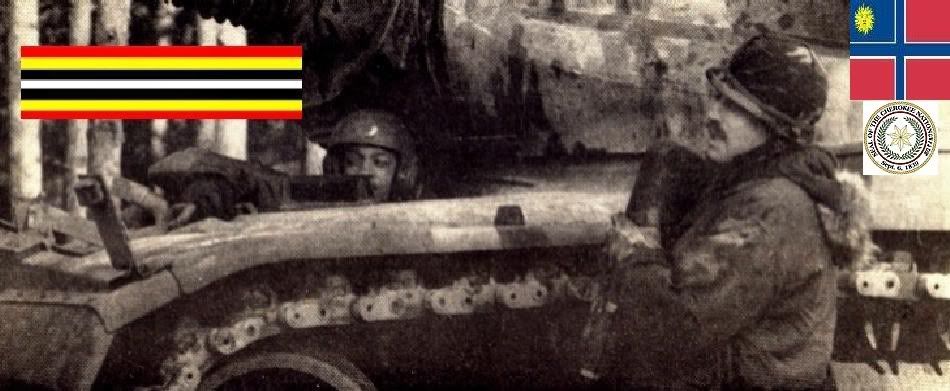|

Chief Big Bear
Warriors Citation
Once the European settlers came to Western Canada, the way of life for the aboriginals was threatened and Big Bear, a Cree
Chief, fought, through protests of peace to make things better for his people. He was branded a troublemaker. This is his
story and the story of his people, an account of one man's losing battle against authority. Big Bear had fought the authorities
by word, his people fought with bullets and both lost. By 1887, Big Bear's people were scattered throughout the country, most
of his family was in Montana, he died alone in January of 1888. It's August 181h, 1876, on the Carlton side of the North Saskatchewan,
the day for signing Treaty #6, between the Lieutenant Governor of Manitoba and the Northwest Territories, Alexander Morris
and the Ruling Chiefs. Artist, Gus Froese has superimposed upon this mural three Indian chiefs who tower over the proceedings,
but are not actually a part of it. To the left is Chief Beardy, who signed the Treaty ten days later on his own turf, then
Chief Big Bear and Chief Poundmaker, who also were not part of the original signing. The whole event takes place under a foreboding
sky, which hints of conflict yet to come. Chief Big Bear, laying on his deathbed called together his two sons, Dark Claw and
his younger brother Wild Horse. Knowing that he would go to the great hunting ground in the sky soon he told them "Soon one
of you will become chief, but in order to do so you must pass a test. The chief knew that Dark Claw only wanted to kill but
his younger son Wild Horse wanted peace more than anything. The honor of being chief mostly fell to the older son, but Big
Bear did not want to give it to his eldest son. Your test shall be go to the over the mountain, down the mighty river, to
a clearing, there is a spring that has the purest and sweetest water I have ever tasted. I was a boy there until the white
man drove us out. Dark Claw's eyes opened wide with anger at the mention of the white man. Bring me back some water from that
spring so I may drink one last time before I die. A mischievous grin came on Dark Claw's face as he looked at his younger
brother. Dark Claw was much bigger than Wild Horse. He was faster but not as smart. He thought this would be an easy way to
become chief. He would follow his brother and wait for him to bring back the water, and then he would kill him and take the
prize to Big Bear, and become chief. You will leave at sunrise and the first to return with the water will be chief.

That night as Dark Claw went hunting, Big Bear called his son to his side. Wild Horse, I do not have to tell you of your brother's
ways. I fear for your safety my son. If you return with the water then I know you have outsmarted your brother. If he returns
with the water then I will know that you are dead. Be careful my son. I cannot give one more help than the other so you must
find a way; on your own. The next morning before the sun rose Dark Claw set off. Wild Horse carefully packed things he might
need in a deerskin bag and left. The hike up the mountain was a treacherous one. Three or four times Dark Horse almost lost
his balance on the small pebbles that were sliding in his wake. Clouds covered the sun and it began to get very dark. Wild
Horse knew it was going to rain so he took shelter in a small cave just off the path. Dark Claw had passed that way not more
than an hour ago, He was constantly on the lookout for somewhere to hide to ambush his brother once he returned. Big Bear,
like Louis Riel, was one of the leaders of the Metis and Plains Indians who tried to unite and press John A. Macdonald's government
for native rights. In 1876, Big Bear refused to sign a treaty he believed would sacrifice his people's rights in exchange
for a reserve. But with buffalo gone and the Cree facing starvation, the treaty was signed in 1882. Big Bear lost control
of some of his warriors which resulted in Wandering Spirit and his men killing nine settlers at Frog Lake, north of today's
Lloydminster, and burning Fort Pitt near the Alberta-Saskatchewan border. The warriors were eventually hanged and Big Bear
was found guilty of treason and sent to Stony Mountain penitentiary near Winnipeg. After two years, he was released to the
Poundmaker reserve near North Battleford, Sask., and died a year later. From: historical accounts & records


LINK TO BRAVEHORSE WARRIORS VOLUME TWO
|

